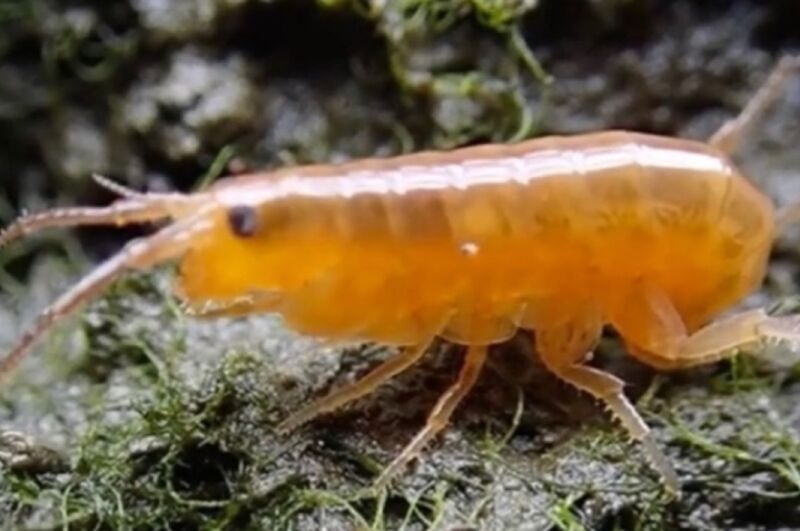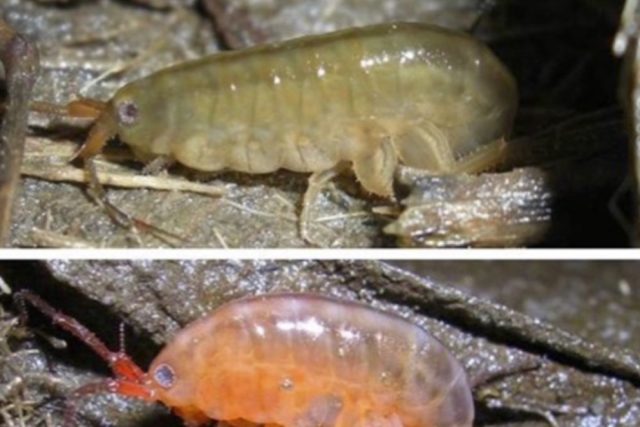Scour the salt marshes of Plum Island Estuary in Massachusetts and you're likely to spot bright orange shrimp lurking among the vegetation and detritus. That unusual hue is a sign that a shrimp has been infected with a parasitic worm, which also seems to affect the shrimp's behavior. Infected shrimp typically become sluggish and spend more time exposed in the open marsh, easy pickings for hungry birds. Now biologists at Brown University have sequenced the DNA of these shrimp to hone in on the molecular mechanisms behind the changes, according to a recent paper published in the journal Molecular Ecology.
“This may be an example of a parasite manipulating an intermediate host to ensure its own transmission between hosts,” said co-author David Rand of Brown University, drawing an analogy to how malaria spreads to humans via the intermediary of mosquito bites. “Rabies could be another relevant example: it drives infected individuals ‘mad’ so they bite others and infect the next host. Learning the molecular mechanisms of these kinds of host-parasite interactions can have important implications for how to manage pathogens generally, and in humans.”
Parasites that control and alter the behavior of their hosts are well-known in nature. Most notably, there is a family of zombifying parasitic fungi called Cordyceps—more than 400 different species, each targeting a particular insect species, whether it be ants, dragonflies, cockroaches, aphids, or beetles. In fact, The Last of Us game co-creator Neil Druckmann has said the premise was partly inspired by an episode of the BBC nature documentary Planet Earth (narrated by Sir David Attenborough) portraying the "zombification" of an ant in vivid detail. Scientists are keen to study Cordyceps to learn more about the origins and intricate mechanisms behind these kinds of pathogen-based diseases.
It's a pretty horrifying process. First, the fungus infiltrates the host's exoskeleton and brain via spores scattered in the air, which fall to the ground. When a foraging ant encounters a spore, the spore attaches to the ant's body, burrowing inside. Once inside, the spores sprout long tendrils called mycelia that eventually reach into the brain and release chemicals that make the unfortunate host the fungi’s zombie slave. The chemicals compel the host to move to the most favorable location for the fungus to thrive and grow. Then the fungus slowly feeds on the host, sprouting new spores throughout the body as one final indignity. Those sprouts burst and release even more spores into the air, which infect even more unsuspecting hosts.
This latest study involves a parasitic worm (trematode) rather than fungus, targeting a particular species of marsh-dwelling brown shrimp (amphipod) rather than insects. In collaboration with the Marine Biological Laboratory in Woods Hole, Massachusetts, Rand has taken his students on annual field trips to Plum Island Estuary since 2013. Many of those students would inevitably be struck by the curious orange hues of Orchestia grillus—the result of infection by the worm Levinseniella byrdi. But the mechanism by which the worm managed to alter the colour and behavior of its host shrimp remained a mystery,
L. byrdi is an avian trematode (or fluke), meaning it ultimately targets birds, but there are three distinct phases in its life cycle. Infected marsh-dwelling birds expel the parasite eggs in their feces, which are then consumed by snails. Those snails, in turn, shed the worm's free-swimming larvae, which can then penetrate the exoskeleton of O. grillus. So the shrimp is technically L. byrdi's second intermediate host. After 25–30 days, the larvae become large cysts within the shrimp's body cavity. That's when the colour shifts from brown to neon orange, and the shrimp shifts to spending more time in exposed areas of the salt marsh. That makes the shrimp more vulnerable to hungry birds. Birds consume the shrimp, become infected, and the cycle starts again.
First, Rand et al. generated two whole-genome sequences for O. grillus, using DNA extracted from a single male leg and a single female leg since leg tissue is unlikely to be infected with trematode DNA. Then they sequenced the DNA of 24 infected shrimp (identified by the telltale orange colour and at least one cyst in the body cavity) and 24 uninfected shrimp, all collected from the banks of a creek in the Plum Island Estuary.
The results: Being infected by trematodes activates gene transcripts in the shrimp associated with pigmentation and how well the shrimp detects external stimuli. At the same time, several gene transcripts associated with immune response are suppressed, which could conceivably explain why 99 percent of the shrimp found in exposed marshes at low tide are infected. Rand et al. suggest that these altered gene expressions provide the parasitic trematode with an evolutionary advantage, giving it a greater chance to increase its numbers. “Infected amphipods become sitting ducks for predators,” Rand said—in this case, birds. “That allows the parasites to spread into a newer, bigger, more robust host organism, and continue to reproduce and propagate their species.”
"These are intuitive results given the clear changes in pigmentation of amphipods as a consequence of infection, and their increased tendency to be found in exposed areas of salt marsh habitat," the authors wrote. "While we acknowledge that predicting organismal behavior from transcriptional profiles spans multiple important cause-effect relationships, the phenotype-genotype associations identified here highlight potential gene targets driving host manipulation in the wild."
Molecular Ecology, 2023. DOI: 10.1111/mec.17093 (About DOIs).



3175x175(CURRENT).thumb.jpg.b05acc060982b36f5891ba728e6d953c.jpg)


Recommended Comments
There are no comments to display.
Join the conversation
You can post now and register later. If you have an account, sign in now to post with your account.
Note: Your post will require moderator approval before it will be visible.